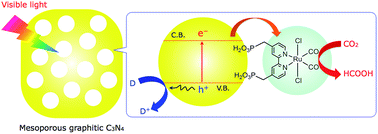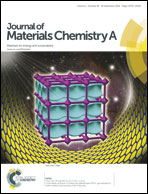The effect of the pore-wall structure of carbon nitride on photocatalytic CO2 reduction under visible light
Abstract
Carbon nitride (C3N4) polymers work as a vital component in a photocatalytic CO2 reduction assembly that operates under visible light when modified with a ruthenium complex, trans(Cl)-[Ru{4,4′-(CH2PO3H2)2-2,2′-bipyridine}(CO)2Cl2], (Ru) as a catalyst. Here we examined the effects of structural properties of carbon nitride on the photocatalytic performance for CO2 reduction into formic acid. Introduction of mesoporosity into the graphitic carbon nitride structure increased the specific surface area, leading to significant enhancement in activity. However, higher surface area (in other words, lower crystallinity) that originated from excessively introduced mesopores had a negative impact on activity, although it is a prerequisite to allow for adsorption of Ru on the carbon nitride surface. Thus, the activity was sensitive to specific surface area and crystallinity of carbon nitride, but is largely insensitive to the pore size and the volume.


 Please wait while we load your content...
Please wait while we load your content...